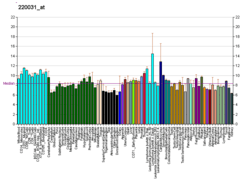OTUD7B
OTU domain-containing protein 7B is a protein that in humans is encoded by the OTUD7B gene.[5][6]
References
- 1 2 3 GRCh38: Ensembl release 89: ENSG00000264522 - Ensembl, May 2017
- 1 2 3 GRCm38: Ensembl release 89: ENSMUSG00000038495 - Ensembl, May 2017
- ↑ "Human PubMed Reference:".
- ↑ "Mouse PubMed Reference:".
- ↑ Evans PC, Taylor ER, Coadwell J, Heyninck K, Beyaert R, Kilshaw PJ (Jul 2001). "Isolation and characterization of two novel A20-like proteins". Biochem J. 357 (Pt 3): 617–23. doi:10.1042/0264-6021:3570617. PMC 1221992. PMID 11463333.
- ↑ "Entrez Gene: OTUD7B OTU domain containing 7B".
Further reading
- Gerhard DS, Wagner L, Feingold EA, et al. (2004). "The status, quality, and expansion of the NIH full-length cDNA project: the Mammalian Gene Collection (MGC)". Genome Res. 14 (10B): 2121–7. doi:10.1101/gr.2596504. PMC 528928. PMID 15489334.
- Suzuki Y, Yamashita R, Shirota M, et al. (2004). "Sequence comparison of human and mouse genes reveals a homologous block structure in the promoter regions". Genome Res. 14 (9): 1711–8. doi:10.1101/gr.2435604. PMC 515316. PMID 15342556.
- Beausoleil SA, Jedrychowski M, Schwartz D, et al. (2004). "Large-scale characterization of HeLa cell nuclear phosphoproteins". Proc. Natl. Acad. Sci. U.S.A. 101 (33): 12130–5. doi:10.1073/pnas.0404720101. PMC 514446. PMID 15302935.
- Evans PC, Ovaa H, Hamon M, et al. (2004). "Zinc-finger protein A20, a regulator of inflammation and cell survival, has de-ubiquitinating activity". Biochem. J. 378 (Pt 3): 727–34. doi:10.1042/BJ20031377. PMC 1224040. PMID 14748687.
- Evans PC, Smith TS, Lai MJ, et al. (2003). "A novel type of deubiquitinating enzyme". J. Biol. Chem. 278 (25): 23180–6. doi:10.1074/jbc.M301863200. PMID 12682062.
- Strausberg RL, Feingold EA, Grouse LH, et al. (2003). "Generation and initial analysis of more than 15,000 full-length human and mouse cDNA sequences". Proc. Natl. Acad. Sci. U.S.A. 99 (26): 16899–903. doi:10.1073/pnas.242603899. PMC 139241. PMID 12477932.
- Heyninck K, Beyaert R (1999). "The cytokine-inducible zinc finger protein A20 inhibits IL-1-induced NF-kappaB activation at the level of TRAF6". FEBS Lett. 442 (2–3): 147–50. doi:10.1016/S0014-5793(98)01645-7. PMID 9928991.
This article is issued from
Wikipedia.
The text is licensed under Creative Commons - Attribution - Sharealike.
Additional terms may apply for the media files.




